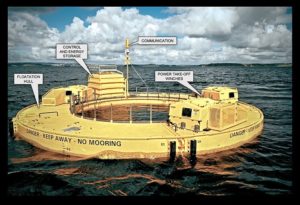Source: earthtimes.org
Published: January 6, 2017

The 4-year-old BOLT design by Fred Olsen is one of the most successful wave-power devices, approaching commercial production after extensive testing in the UK’s Falmouth testing area. BOLT image; Credit: © Fred Olsen
Norwegian company, Fred Olsen are equipping the US Navy in Hawaii with BOLT Lifesaver modules that produce wave powered electricity. These well-developed buoy-like devices can produce between 30 and 50KW from simple waves, while the greater emphasis recently has been on power from tidal flow. However, in Northern Europe, renowned fast tidal currents favouring sites around the Pentland Firth next to Orkney, seem set to finally set a precedent for massive tidal energy actually produced for a National Grid. In 2014, 1.9GW was estimated to be obtainable from this turbulent Channel by Oxford and Edinburgh University researchers, after much argument about what could be achieved. Now the aim is to use 269 turbines here, following a ground-breaking Shetland initiative just a little further north that stimulated this commercial interest.
While Scotland hopes to be comfortably and totally renewable in energy by 2020 (183 % of their generation should be renewable by 2030), renewable power generation and waste management are still progressing fast. They have reduced emissions there by 46% since 1990 already, way above the 2020 target. Now a $6bn project is starting to transform these tides into enough power for 750,000 homes (about 1600MW), equivalent to a nuclear power station. This sits uncomfortably with the English energy solution of a Chinese/French franchised nuclear power station in the south. The British government do have many projects, such as in Swansea Bay which will convert the Bays tidal push into a great amount of energy. The projected power output of 16 underwater turbines is 320MW, which is comparable to that from the fast tides around Orkney (The Severn Estuary at Swansea has a large 8.5m tidal range during Spring Tides.)
The technology in Scotland is derived from Aquanator, an early Atlantis turbine that was use in Victoria, Australia while an uprated system was later installed. In Singapore, rapid Atlantis development took place before a move to Europe, where they formed an international consortium to claim development rights in the Pentland Firth for the MeyGen Project, based in Edinburgh. Other projects include FORCE in Nova Scotia and a CECEP/Dongfang collaboration in China.
Meygen is now the biggest tidal project in Europe, ready to use a new tidal turbine system on the seabed, with collaborators including several industry leaders such as Lockheed Martin Corporation. The 4 original turbines weigh 200 tonnes and each produce 1.5MW, being built locally in redundant oil and gas fabrication yard location, which is another kind of recycling!
Let’s hope the US Navy pay attention to Fred Olsen and all the other players in these new and continually-developing technologies designed to harness that elusive but very obvious energy within waters everywhere.
